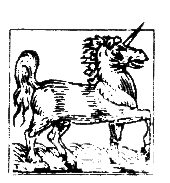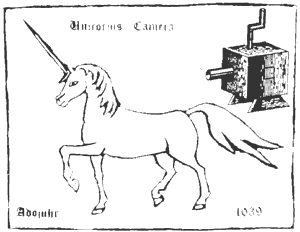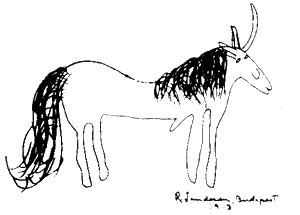S. Dr. Landescu, when you spoke in your
talk today about the origins of zoological science, and of the mythical animals which the first treatises described, you made
reference to the Unicorn, is that not so?
L. Yes indeed, when I spoke about the Phisiologus, one of the first known zoological treatises, I mentioned
the Unicorn one amongst other fantastic animals described in it.
S. Dr. Landescu, I have the impression that when you spoke about flying dragons and mermaids etc., you referred
to the Unicorn in a different way. That is, you referred to it in a tone that made the audience believe that for you
this animal is not as fantastic as the other examples described. I would like to ask you: Do you believe
that Unicorns existed?
L. Mr. Spaulding, it seems to me that your question strays from the
scientific nature of this conference.
S. Dr. Landescu, forgive my insistence. If I ask this question it is because when you referred to it, I
repeat, you did so in a very special tone. In the mind of all those present the notion remained that the
aforementioned animal was real and not fantastic.
L. Well, in truth, perhaps I used, let's say, a somewhat vehement
tone, but I don't believe I gave the impression that you mention. Well,
perhapsÉ
S. Dr., you are a scientist reputed internationally. Maybe you are
afraid of saying something that does not correspond to the general criterion
of science? I think that anything that you raise will be difficult to dismiss.
For this reason I venture to repeat my question: Do you believe that unicorns
existed and that they are not just a fable?
L.Look Mr. Spaulding, as scientists we have very strict norms. We only speak about things that we can prove.
For us, everything that is improbable remains in the field of speculation. However, if you promise me that you will not
publish my words as scientific claims, but rather as the outcome of an informal chat outside this conference, I will tell
you some things that I believe about Unicorns.
S. Agreed Dr., it is understood that everything that you tell me from now on will be totally
informal and should not be taken as scientific truth.
L. Thank you, Mr. Spaulding. So many things have been said about Unicorns that, frankly, I don't know how to
begin. It is thought that their legend originated when the first Western travelers saw a rhinoceros and thought that
it was a horse with a horn. In short, in the field of pure speculation, much can be said about it.
S. Dr. Landescu, hypothetically is there any possibility that the
Unicorn could have existed?
L. Well, many animal species existed which, for various reasons, later became extinct. In the same way,
the Unicorn could have existed hundreds, thousands, or maybe millions of years ago.
S. If the Unicorn had lived, in what species would you have classified it, Dr. Landescu?
L. In the equine family, naturally, derived from the "Equus caballus
ferus". Of course this is an informal opinion. Don't you forget that.
S. Could you give a description of it, just as you imagine it hypothetically,
and could you refer to the places where it could have lived?
L. I think of the Unicorn as a medium-sized equine with a long, arched
neck, abundant, swaying manes, fine hooves, and a large horn on its forehead,
slightly curved on the upper part. As far as the places it inhabited are
concerned, it could have lived in some areas of Central Asia, Africa, and
Europe.
S. Dr., could such a species disappear without leaving any trace? One assumes that
vestiges of at least the horn would have remained.
L. Mr Spaulding, you have touched upon an interesting subject. It
is usual to think of an animal's horn being made up of hard matter. This
is correct in the case of a bull, a goat, a deer, etc. In the case of the
Unicorn the horn might not have been made of bone, but a cartilaginous protuberance
made up of organic matter. Therefore, upon the death of the animal, this
protuberance disappears through decomposition.
S. Dr. Landescu, could you deduce from this that many of the prehistoric
equine remains that have been found, could have been from Unicorns and not
horses?
L. Yes, that is likely.
S. Dr. Could you tell us something about its extinction? What do you put down to the
disappearance of this probable species?
L. Many factors could be considered. There are so many that to list them would be almost
impossible. As we are talking in an imaginary, hypothetical way, I am going to name a few:
The first would be man. If man appeared when the Unicorn already inhabited the earth, it is almost
certain that he would have exterminated it for food or sporting reasons. Another factor could be a
climate change that was so severe that the Unicorn did not have time to adapt. And another, which is
the one that I fall for, is that the Unicorn was a hybrid.
S. Are you trying to say that it could have resulted from a cross between two different species?
L. Exactly. Just as the hinny is the result of the cross between
a horse and a donkey, the Unicorn, for example, could come from the cross
between a horse and a gazelle. By wiping out any one of the two main components,
the third disappears. Personally I think that, in this case, the first to
disappear was the gazelle.
S. Through extinction?
L. Through extinction or migration.
S. Dr., I understand that gazelles have a hard horn made of bone. How is it
possible that, the Unicorn being a derivative of it, its horn should have been made of cartilage?
L. Everything is possible in nature. It is common that stupid children are born of brilliant parents
and vice versa. Thus it is not strange that a soft horn should have emerged from a hard one.
S. Dr., I consider everything said to be very interesting. I hope
to interview you on another occasion on a subject closer to your specialty.
I want to ask you a final favor. During our chat I noticed that, perhaps
absent-mindedly, you sketched a silhouette of a Unicorn with your pen. Would
you be so kind as to present it to my journal, so that the readers could
have a graphic image of the informal chat that we have had?
L. You embarrass me, Mr. Spaulding. I draw very badly and I think
that the Unicorn deserved something better.... |


